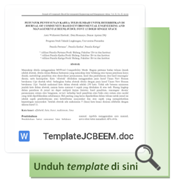Study of Beach Litter on Remote Island, Case Study: Ainoshima Island, Japan
DOI:
https://doi.org/10.23969/jcbeem.v7i2.10102Keywords:
Litter, Transect Survey, Remote Island, Beach, OSPAR, NOAAAbstract
Ainoshima Island is a Remote Island located north of Kyushu Island which is also known as a popular tourist attraction named Cat Island. The island is inhabited by a small population but is frequented by tourists to enjoy nature and fishing. The coastline is in the form of cliffs and sandy beaches, but there is a lot of marine debris on the sandy beaches. In addition, its location allows waste from the surrounding area to be carried by currents to this island. This research examines the diversity of categories and types of macroplastic litter trapped on the sandy beach of Ainoshima Island. Survey transects were conducted in the spring of 2023 via visual observation based on a survey method developed by NOAA, in 2012. The survey results were then categorized based on a photo guide database from the OSPAR Maritime Area for Active Monitoring of Marine Debris on the Beach. Data on the types of waste found are divided into artificial polymer materials (plastic), rubber, cloth, paper/cardboard, processed/finished wood, metal, glass, and ceramics. As a result, the plastic category is the dominant category of the total type of waste trapped in sandy beach areas.
Downloads
References
Adyel, T. M. (2020). Accumulation of plastic waste during COVID-19. Science, 369(6509), 1314–1315.
Anggraini, N., Muis, R., Ariani, F., Yunus, S., & . S. (2021). Model of Solid Waste Management (SWM) in Coastal Slum Settlement: Evidence for Makassar City. Nature Environment and Pollution Technology, 20(2).
Armitage, S., Awty-Carroll, K., Clewley, D., & Martinez-Vicente, V. (2022). Detection and Classification of Floating Plastic Litter Using a Vessel-Mounted Video Camera and Deep Learning. Remote Sensing, 14(14), 3425.
Barnes, D. K. A., Galgani, F., Thompson, R. C., & Barlaz, M. (2009). Accumulation and fragmentation of plastic debris in global environments. Philosophical Transactions of the Royal Society B: Biological Sciences, 364(1526), 1985–1998. https://doi.org/10.1098/rstb.2008.0205
Coe, J. M., & Rogers, D. B. (Eds.). (1997). Marine Debris. Springer New York.
Di-Méglio, N., & Campana, I. (2017). Floating macro-litter along the Mediterranean French coast: Composition, density, distribution and overlap with cetacean range. Marine Pollution Bulletin, 118(1–2), 155–166.
Galgani, F., Hanke, G., Werner, S., & De Vrees, L. (2013). Marine litter within the European Marine Strategy Framework Directive. ICES Journal of Marine Science, 70(6), 1055–1064.
Gall, S. C., & Thompson, R. C. (2015). The impact of debris on marine life. Marine Pollution Bulletin, 92(1–2), 170–179.
Gesamp.pdf. (n.d.).
Khairunnisa, A. K., Fauziah, S. H., & Agamuthu, P. (2012). Marine debris composition and abundance: A case study of selected beaches in Port Dickson, Malaysia. Aquatic Ecosystem Health & Management, 15(3), 279–286.
Koly, F. V. L., Waskita, A. M., Plaimo, P. E., & Aryawan, I. M. D. J. (2021). Marine litter composition and density in Alor Island. 020039.
Moore, C. J. (2008). Synthetic polymers in the marine environment: A rapidly increasing, long-term threat. Environmental Research, 108(2), 131–139.
Pacilan, C. J., & Bacosa, H. (2022). Assessment of Macroplastic Litter on the Coastal Seabeds of Sultan Naga Dimaporo, Lanao Del Norte, Philippines. Journal of Marine and Island Cultures, 11(2).
Perumal, K., Boopathi, V., Chellaiyan, S., Muthuramalingam, S., & Raja, P. (2021). Sources, spatial distribution, and abundance of marine debris on Thondi coast, Palk Bay, Southeast coast of India. Environmental Sciences Europe, 33(1), 136.
Ritchie, H., & Roser, M. (2022). Plastic Pollution. Plastic Pollution. https://ourworldindata.org/plastic-pollution
Street, C., & Wc, L. (n.d.). OSPAR’s vision is of a clean, healthy and biologically diverse North-East Atlantic used sustainably.














